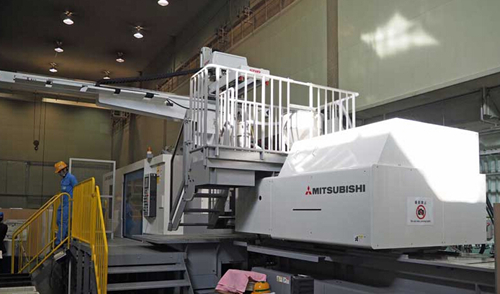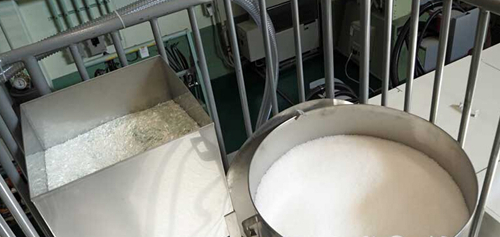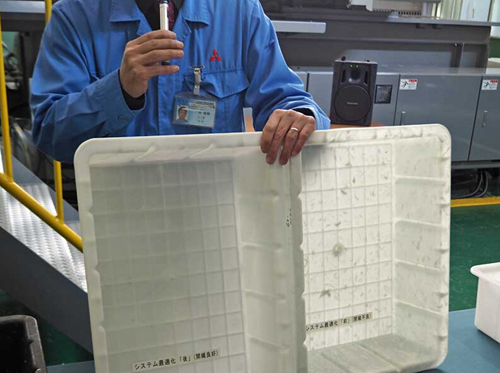Mitsubishi Heavy Industries Plastics Technology Co., Ltd. (Headquarters: Nagoya City) announced on March 2, 2015 that it has developed a "D-LFT system" that is a kneading/metering/ejection device that molds high-strength components by maintaining the length of the fibers in the glass fiber reinforced resin. (See Figure 1, LFT: Direct Long Fiber reinforced Thermoplastics, long fiber reinforced thermoplastics). It is characterized by separate input of resin (polypropylene, PP) and glass fiber (Fig. 2). Compared with the use of glass fiber-containing particles, it is expected to reduce the material cost by 25% and the cost of the molded article by 11%. The purpose of aiming is to replace large steel parts such as automobile body parts.

Figure 1: Injection molding machine equipped with "D-LFT system" (Mitsubishi Heavy Industries Plastics Technology)

Figure 2: Material input. Resin (PP) and glass fiber (length 9mm) were put separately
The glass fiber-reinforced long fiber particles have a length of 8 to 11 mm, and the length of the fibers is the same. However, in the kneading process before the resin is injected, the glass fibers are usually broken, resulting in a fiber of about 2 mm after molding. Mitsubishi Heavy Industries Plastics Co., Ltd. has previously developed an "LFT screw" that ensures a fiber length of about 5 mm by improving the shape and control of the screw for mixing. The company has also developed a process for mixing glass fibers having a length of 9 mm in the middle of the process of kneading a resin containing no glass fibers by means of an LFT screw. The length of the fiber left in the molded product is about 5 mm, which ensures the same strength as the original, and "the foot can replace the steel parts" (Mitsubishi Heavy Industries Plastics Technology Representative Director Kubota Hoss). In addition, users can reduce material costs by purchasing fiberglass and resin separately.
Since the glass fiber is in a bundled state, if it is not sufficiently unwound during kneading, the glass fiber is unevenly distributed and sufficient strength cannot be secured (Fig. 3). In order to develop hardware and control software that unwinds the fiberglass without breaking it, the developer has paid a lot of thought. During the development, it cooperated with the fiber manufacturer Nippon Electric Glass Co., Ltd. In addition, the two companies will work together to build a system to provide formula information and technical support to users of the D-LFT series to help users select resin materials and fibers and determine the amount of additives that match the amount of fiber.

Figure 3: Molded articles after development and development. Solidified glass fiber in the right molded product ensures sufficient strength
The D-LFT system is to be used in combination with a medium-sized injection molding machine such as a mold clamping force of 550 tf or more and an "emII" (clamping force of 1050 tf to 3500 tf) in the injection molding machine "MEII+ series" of Mitsubishi Heavy Industries. According to reports, the price is 1.5 to 1.6 times that of a conventional screw, but it is lower in price than a model made by a German manufacturer that can use long fibers.
Ceiling Lamp ,Led Ceiling Light Fixture,Led Ceiling Lights For Living Room,Ceiling Mounted Light
Zhongshan Seekyo Lighting CO., Ltd. , https://www.seekyomodernlamp.com
